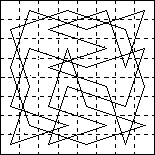Strictly speaking, of course, our own present-day queen and bishop are most unorthodox pieces. The original chess had no such powers. Since, however, I write as a modern, it will be only fair to treat the early queen and bishop as forces new to our twentieth century chess.
The Persian name for their fourth best piece was fers, or fars, signifying a grand vizier or minister, and derived from the Persian farzin — “distinguished”. The term was borrowed by the Arabic scribes, and though untranslatable in Arabic, the term “fers” travelled with the piece.
[In a similar way we get “rook” from the Persian rukh — a war chariot or car.]
A great deal has been written on this and other mediaeval pieces,[2] so, briefly, I may say it moved one square diagonally in any direction. At a later period a queen made by promotion could for its first move leap to the next square but one to its standing square in rank, file or diagonal, providing such square were unoccupied.
These features are all illustrated in the following problem.
|
|
The solution commences 1 QB3. White now threatens QKt4 mate. If Black defends by QKt4, the new queen at Kt8 leaps to Kt6, giving mate. If QK4, new queen leaps to K6, giving mate. If RxQ or RKt6 or R5, then KtR4 mate, and if anything else, the threat.
[1]Cheltenham Examiner 10 April 1913.
[2] W. S. Branch follows this article with extensive historical notes about the fers, including similar pieces in Chinese, Burmese, Siamese and Japanese chess. I believe he had done extensive research on the history of chess himself, and was not relying on H. J. R. Murray's A History of Chess which was first published that year.
 The British Chess Problem Society
The British Chess Problem Society
